Moment's Notice
Recent CDs Briefly Reviewed
(continued)
Dewey Redman Quartet
The Struggle Continues
ECM 1225
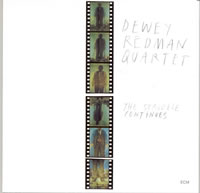 Even though this 1982 recording is a sterling example of how the tenor saxophonist easily shifted between seemingly disparate styles, articulating a Texas saxophone narrative that encompasses Arnett Cobb and Ornette Coleman, it is not the most comprehensive survey of Redman’s work. He sticks exclusively to his main horn; and instead of the unusually configured ensembles he led in the ‘70s, Redman presides over a standard quartet with drummer Ed Blackwell, pianist Charles Eubanks and bassist Mark Helias.
Even though this 1982 recording is a sterling example of how the tenor saxophonist easily shifted between seemingly disparate styles, articulating a Texas saxophone narrative that encompasses Arnett Cobb and Ornette Coleman, it is not the most comprehensive survey of Redman’s work. He sticks exclusively to his main horn; and instead of the unusually configured ensembles he led in the ‘70s, Redman presides over a standard quartet with drummer Ed Blackwell, pianist Charles Eubanks and bassist Mark Helias.
Still, the album arguably makes the best case of Redman’s albums for his rightful place among jazz’s great tenor players. Whether he was carving out the contours of a free bop blowing vehicle like “Thren,” gracefully swinging on the waltz “Love Is,” or cooking with grease on “Turn Over Baby,” Redman led with his sound, which exerted a palpable gravitational pull on the material at hand. It is therefore not his facility with the bebop lexicon that makes Redman’s set-closing take on Charlie Parker’s “Dewey Square” impressive, but the hearty, occasionally gruff jocularity his sound conferred upon the material.
One of the finer aspects of Redman’s leadership was his consistent ability through the years to bring together musicians at different stages of their respective careers, creating combinations heard nowhere else. The Struggle Continues features a particularly pungent blend of voices. At this time, Blackwell already had at least one foot in the pantheon; Eubanks was more active on the New York scene than his curiously scant discography would indicate; having been in New York for just a few years, Helias had nevertheless racked up a lot of serious sideman credits. Throughout the album, they reiterate their shared, sure instincts about elasticity and heat: when to stretch the groove; when to ratchet the intensity; and when to let the music snap back to its starting point.
However, every time Redman ramps it up or slips in at the turnaround, it is immediately obvious why he’s the leader; there’s a casually asserted authority in his every note.
–Bill Shoemaker
Samo Salamon European Quartet
Fall Memories
Splasc(h) 2514.2
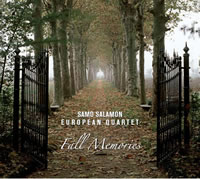 It's exciting to watch musicians develop and take center stage coming from regions that haven't been among the core areas of jazz development in Europe. Guitarist Samo Salamon, hailing from Maribor in northern Slovenia, is a case in point. Salamon is no newcomer; he has several CDs under his belt, some of them internationally acclaimed, and his studies in NYC with John Scofield among others allowed him to develop ongoing collaborations with such luminaries as Josh Rosenman, David Binney, and Drew Gress. But this new recording with European musicians sounds to me more mature, satisfying and finally more personal than previous efforts. This is the second edition of his European Quartet – accordionist Luciano Biodini replaces saxophonist Julian Argüelles, while tuba player Michel Godard and drummer Roberto Dani return. Although the new combination of instruments create faint echoes of traditional musics, this is vibrant contemporary jazz that reflects Salamon’s open admiration of Ornette Coleman – his first self-produced CD was titled Ornethology. The pieces are invigorated by freely improvised sections as well as Salamon’s command of modern guitar styles (while never an imitator, Salamon knows his Scofield and Frisell).
It's exciting to watch musicians develop and take center stage coming from regions that haven't been among the core areas of jazz development in Europe. Guitarist Samo Salamon, hailing from Maribor in northern Slovenia, is a case in point. Salamon is no newcomer; he has several CDs under his belt, some of them internationally acclaimed, and his studies in NYC with John Scofield among others allowed him to develop ongoing collaborations with such luminaries as Josh Rosenman, David Binney, and Drew Gress. But this new recording with European musicians sounds to me more mature, satisfying and finally more personal than previous efforts. This is the second edition of his European Quartet – accordionist Luciano Biodini replaces saxophonist Julian Argüelles, while tuba player Michel Godard and drummer Roberto Dani return. Although the new combination of instruments create faint echoes of traditional musics, this is vibrant contemporary jazz that reflects Salamon’s open admiration of Ornette Coleman – his first self-produced CD was titled Ornethology. The pieces are invigorated by freely improvised sections as well as Salamon’s command of modern guitar styles (while never an imitator, Salamon knows his Scofield and Frisell).
One of the key characteristics of the music is the usage of odd rhythms and grooves that are asymmetric but rollicking. The CD opens with an acrobatic tuba solo over an alternating even and odd tempos stated by the guitar in the low register, a spacious, startling sound that cannot fail to grab the attention of the listener; then the dry tattoo of drum joins in, while the two initial instruments switch roles, tuba joined by the accordion in keeping the ostinato. Following similar logics, there are continuous exchanges of roles among the instruments throughout the album that creates a shift in perspective and keeps the sound always fresh. Salamon's guitar sound has a rough edge and occasionally uses rockish distortion; there’s urgency in his phrasing even when he's using a cleaner timbre. The freewheeling contributions of his colleagues, interjecting at will during the solos, always make for interesting listening: the inherent sentimentality of accordion countered by the gruff comments from the tuba, the long guitar sounds interrupted by the clattering of percussions, at time attaining the serene impersonality of a bunch of a stone masons. For originality of conception and sonic freshness this stands up to – and sometimes reminds me of – the best Threadgill.
–Francesco Martinelli
Roger Sessions + Ralph Shapey
Sessions & Shapey
Bridge 9243
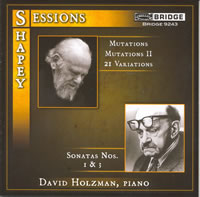 Roger Sessions and Ralph Shapey are composers not frequently associated with each other. Sessions came into his own as a neo-classicist in the late 1920s and early ‘30s; by the ‘50s, he pivoted his use of long flowing lines to fit serialist templates. His later music, however, did not have the severe, cluster-based pyrotechnics of Shapey’s. Still, there’s something of an arc in pianist David Holzman’s program of compositions by the two. Even though Sessions’ “Piano Sonata #1” (1930) opens the album with an austere lyricism that reflects Sessions’ New England roots, the piece incorporates everything from cabaret music and jazz to the stentorian classicism of Paul Hindemith, and can be heard as something of an aesthetic travelogue. The ambiance of Sessions’ “Piano Sonata #3” (’64-5) shifts from mystery to lament over the course of the three movements, as one would expect from a memorial – in this case, JFK. Its emotional integrity is particularly noteworthy given the structural rigors of this atonal work. This is Shapey’s’ strong suit, as well. Sessions’ later music and early Shapey pieces like “Mutations” (1956) conveyed a semblance of tonality and cadence in strictly serial passages, which supports to an extent the comparisons between Sessions, Shapey and Stepan Wolpe made by Holzman and others. However, the explosive passages in Shapey’s “Mutations II” (1966) and “21 Variations” (1978), beg comparison with Cecil Taylor, as Shapey uses cells of materials that streak across the moment, the juxtaposition of extreme registers, and other devices to give the music a extemporaneous feel. Holzman’s insights into both composers are constantly revealed in these riveting performances, and his linkage of Sessions and Shapey is illuminating and instructive.
Roger Sessions and Ralph Shapey are composers not frequently associated with each other. Sessions came into his own as a neo-classicist in the late 1920s and early ‘30s; by the ‘50s, he pivoted his use of long flowing lines to fit serialist templates. His later music, however, did not have the severe, cluster-based pyrotechnics of Shapey’s. Still, there’s something of an arc in pianist David Holzman’s program of compositions by the two. Even though Sessions’ “Piano Sonata #1” (1930) opens the album with an austere lyricism that reflects Sessions’ New England roots, the piece incorporates everything from cabaret music and jazz to the stentorian classicism of Paul Hindemith, and can be heard as something of an aesthetic travelogue. The ambiance of Sessions’ “Piano Sonata #3” (’64-5) shifts from mystery to lament over the course of the three movements, as one would expect from a memorial – in this case, JFK. Its emotional integrity is particularly noteworthy given the structural rigors of this atonal work. This is Shapey’s’ strong suit, as well. Sessions’ later music and early Shapey pieces like “Mutations” (1956) conveyed a semblance of tonality and cadence in strictly serial passages, which supports to an extent the comparisons between Sessions, Shapey and Stepan Wolpe made by Holzman and others. However, the explosive passages in Shapey’s “Mutations II” (1966) and “21 Variations” (1978), beg comparison with Cecil Taylor, as Shapey uses cells of materials that streak across the moment, the juxtaposition of extreme registers, and other devices to give the music a extemporaneous feel. Holzman’s insights into both composers are constantly revealed in these riveting performances, and his linkage of Sessions and Shapey is illuminating and instructive.
–Bill Shoemaker
John Stevens + Evan Parker
Corner to Corner + The Longest Night
Ogun OGCD 022/023
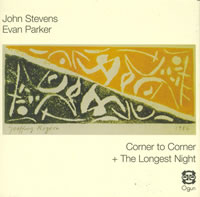 This is most probably a position shared by very few: The Longest Night is the most important recording John Stevens and Evan Parker made together. But, it is defendable. Despite their collaboration on prior Spontaneous Music Ensemble classics like Karyobin (1968; Chronoscope) and Quintessence (’73-4; Emanem), this 1977 duo exchange – originally released by Ogun in two single-LP volumes – occurred when both musicians had been freely improvising for more than a decade, and had frequently encountered each other, usually within the context of SME. True, neither had taken a quantum leap, stylistically, subsequent to Quintessence (which documents a more evolved ensemble approach than heard on SME’s early albums). But, the head-on dynamic of a duo, which had previously brought out particularly focused playing from both Stevens and Parker (with Trevor Watts and Paul Lytton, respectively), proved to be especially catalytic on this occasion. There’s a determined, bristling energy to Parker’s soprano sputters and squalls and the spatters Stevens created with both his modified kit (no bass drum; two hi hats; a child’s snare) and cornet that crystallized a shift that was afoot in British improvised music. Having successfully finished their initial project of separating their music from jazz antecedents, Stevens, Parker and some of their contemporaries had moved on to the articulation of a new virtuosity. Stevens speaks to this in his brief liner notes for the original LPs, referring to Parker and himself as among the “most skilled” practitioners of improvised music, citing the album as representative of the “latest development” in the music, and evaluating it as the “best” created by the duo. The Longest Night stands up well next to Corner to Corner, recorded in ’93 and previously available as a single CD; even though there are meatier examples of Parker’s circular breathing and multiphonics, and Stevens’ drumming has more of a continuity-endowing bounce, this is a continuation of prior dialogues instead of a wholly new chapter to their collaborations. Only a few releases rise to this level of “document” each year, conveying real insight into why a form of music and/or its leading exponents remain vital, instead of being merely historical. This is one of them.
This is most probably a position shared by very few: The Longest Night is the most important recording John Stevens and Evan Parker made together. But, it is defendable. Despite their collaboration on prior Spontaneous Music Ensemble classics like Karyobin (1968; Chronoscope) and Quintessence (’73-4; Emanem), this 1977 duo exchange – originally released by Ogun in two single-LP volumes – occurred when both musicians had been freely improvising for more than a decade, and had frequently encountered each other, usually within the context of SME. True, neither had taken a quantum leap, stylistically, subsequent to Quintessence (which documents a more evolved ensemble approach than heard on SME’s early albums). But, the head-on dynamic of a duo, which had previously brought out particularly focused playing from both Stevens and Parker (with Trevor Watts and Paul Lytton, respectively), proved to be especially catalytic on this occasion. There’s a determined, bristling energy to Parker’s soprano sputters and squalls and the spatters Stevens created with both his modified kit (no bass drum; two hi hats; a child’s snare) and cornet that crystallized a shift that was afoot in British improvised music. Having successfully finished their initial project of separating their music from jazz antecedents, Stevens, Parker and some of their contemporaries had moved on to the articulation of a new virtuosity. Stevens speaks to this in his brief liner notes for the original LPs, referring to Parker and himself as among the “most skilled” practitioners of improvised music, citing the album as representative of the “latest development” in the music, and evaluating it as the “best” created by the duo. The Longest Night stands up well next to Corner to Corner, recorded in ’93 and previously available as a single CD; even though there are meatier examples of Parker’s circular breathing and multiphonics, and Stevens’ drumming has more of a continuity-endowing bounce, this is a continuation of prior dialogues instead of a wholly new chapter to their collaborations. Only a few releases rise to this level of “document” each year, conveying real insight into why a form of music and/or its leading exponents remain vital, instead of being merely historical. This is one of them.
–Bill Shoemaker
Trevor Watts + Jamie Harris
Ancestry
Entropy ESR 016
Trevor Watts Drum Orchestra
Burundi Monday
FMR CD198-0206
Trevor Watts Moire Music
Live in Karlsruhe
FMR CD232-0307
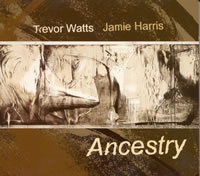 In the early ‘60s, saxophonist Trevor Watts played a vital role in the creation of British free improvisation, but his later musical path may have been shaped as much by London’s significant community of émigré African musicians. For almost three decades, Watts has been an advocate of African rhythms and cross-cultural musical integration, transferring his strong interest in the collective aspect of free improvisation into polyrhythmic group dialogue, often using folk-like, minimalist melodic materials. Lately the FMR label has been issuing Watts’ archival tapes, enriching our view of his work. At the same time, Michigan’s Entropy has released a CD of Watts’ current duo with hand drummer Jamie Harris. (For a detailed account of Watts’ work, see A Wider Embrace in PoD Issue 4 which includes a live review of the Watts/ Harris duo, an interview with Watts and an annotated discography.)
In the early ‘60s, saxophonist Trevor Watts played a vital role in the creation of British free improvisation, but his later musical path may have been shaped as much by London’s significant community of émigré African musicians. For almost three decades, Watts has been an advocate of African rhythms and cross-cultural musical integration, transferring his strong interest in the collective aspect of free improvisation into polyrhythmic group dialogue, often using folk-like, minimalist melodic materials. Lately the FMR label has been issuing Watts’ archival tapes, enriching our view of his work. At the same time, Michigan’s Entropy has released a CD of Watts’ current duo with hand drummer Jamie Harris. (For a detailed account of Watts’ work, see A Wider Embrace in PoD Issue 4 which includes a live review of the Watts/ Harris duo, an interview with Watts and an annotated discography.)
Burundi Monday, from 1983, illustrates Watts’ essential impulses. Recorded at London’s 100 Club, the sextet combines drummer Liam Genockey and violinist Peter Knight -- both of whom played in the folk rock band Steeleye Span – with South African bassist Ernest Mothle and West African drummers Mmadi Kamara and Nana Tsiboe. Given the group’s relative obscurity, it may be hard to acknowledge how truly fine it is. Effectively anchored in the premises of John Coltrane – and to a certain extent Ornette Coleman`s Prime Time – the band’s collective identity builds on an earlier fusion of African and Arabic musical elements, fusing polyrhythms and modal improvisation. At the outset of the 35-minute title track, Knight’s bowed violin echoes the shennai-like wail of Watts’ scaling, circular soprano; later the plucked violin assumes an oud-like quality. The constant rhythmic pulsation couples with a certain conversational quality to make this music intensely engaging--it seems almost brief. As long as the track is, you don`t experience it as clock time, its constant activity suggesting the activity of consciousness.
The raw expression of the Drum Orchestra is at times submerged in the ensemble polish of Moire Music`s Live in Karlsruhe, a previously unreleased tape from 1989. What`s extraordinary here is the further meshing of energies, matching rapid, angularly boppish lines with the celebratory quality of African pop music. This version of Moire Music is a nonet with Genockey and Tsiboe still in the Watts drum corps, with Naniah Appia as well. A diverse group of keyboards includes pianist Veryan Weston, who happily blends rhythmic precision and harmonic freedom in his solo opportunity; accordionist Richard Granville-Smith, a fine orchestral player who duets wonderfully and mysteriously with Weston on “Shadows”; and Liane Carroll, who adds dense textural enrichments with keyboards and also sings wordlessly and brilliantly (In the past few years, she`s launched a more conventional career as a jazz vocalist: unthinkably for one of that breed, she actually deserves wider attention). Electric bassist Colin Gibson, saxophonist Simon Picard and Watts complete the band. The sheer scale and collective focus are compelling, and again there are long tracks that don`t seem long, like the opening “Dreams,” stretching to 25 minutes. The feeling of dense, controlled music extends throughout the concert, including the “Themes for America Nos. 4 and 1.” The music takes in a broad terrain, from movie music tension to searing free jazz, the sheer complexity of the mix suggestive of the contrapuntal collective power that the Dizzy Gillespie Big Band used to manage on its Afro-Cuban forays. Watts clearly feeds on the rhythmic density, soloing with a fervor and invention that are delights to hear.
It`s a tribute to both Watts and Jamie Harris that their duo can stand comparison to the achievements of Watts` earlier, large-scale projects, but there`s a special empathy apparent in Ancestry. From the opening “Alpino” with Watts’ soprano suggestive of tarogato and shennai, there’s the notion that this might be the folk music of an unknown culture, an impression that ebbs and flows throughout the program of 13 short pieces, like the mysterious “Ghetto Life was here (memory of Cracow)” with its suggestions of blues, klezmer and the middle East becoming the ground for Watts’ most extended foray into circular-breathing alto. Even as he’s managed to get his touring unit reduced to a minimum, Watts’ intensity makes him the center of a major event. His playing is filled with a kind of pan-ethnic declarative power that suggests a musician from everywhere. Harris, a virtuoso of polyrhythms, takes on almost a community role, grounding and encouraging the saxophonist’s fluid lines. The two succeed where few duos do, specifically because of the time invested and the vitality of the rhythmic structures. From the delightfully backwards-sounding “Balintan” to the bagpipe wail of “Maribor Memories” and the accelerating “Kerrytown,” circular breathing and hand drumming create both a continuity and a community of sound.
–Stuart Broomer